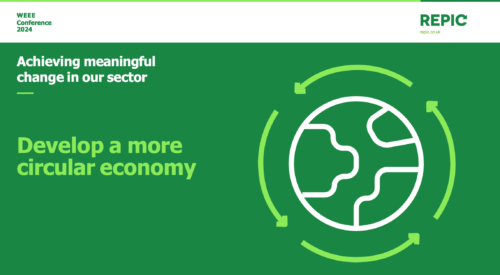How will higher WEEE targets be met?
6 minutes
REPIC is an industry-leading provider of producer responsibility solutions for waste electrical and electronic equipment (WEEE), batteries and packaging. REPIC operates approved producer compliance schemes as well as supporting producers with wider environmental compliance and sustainability objectives.
REPIC is an industry-leading provider of producer responsibility solutions for waste electrical and electronic equipment (WEEE), batteries and packaging. REPIC operates approved producer compliance schemes as well as supporting producers with wider environmental compliance and sustainability objectives.
REPIC is trusted by many leading household brands to help them meet their producer responsibility obligations across EEE, Batteries and Packaging. REPIC also supports them with their wider environmental, compliance and sustainability objectives.

Call REPIC on 0161 272 0001
or email at info@repic.co.uk
This year, the UK WEEE collection target (set by the WEEE Directive) has increased from 45% of EEE Products placed on the market (POM) to either 65% of EEE products POM or 85% of WEEE Generated (WG). In 2017, the UK WEEE system achieved an overall collection rate of 40%. Defra recognises that there are legitimate alternative routes for end-of-life product disposal alongside the official UK WEEE system, and so use substantiated estimates to demonstrate UK compliance with the 45% POM target. It is expected that similar circumstances will arise in 2018.
It is recognised that achieving the higher targets this year will be a challenge, and one which all of the industry needs to contribute to. REPIC is continuing to develop practical, on the ground, methods of obtaining more WEEE and is aware others are doing the same. However, in order to achieve the right results, allow industry to plan and assist Government in developing effective future policy implementation, delivery and enforcement, it is important that we fully understand what happens to an EEE product during its working life through to final disposal. Currently the industry has some significant knowledge gaps in this.
Establishing the timeline between the original purchase of a product and when it is captured as WEEE is more complex than, for example, packaging, where consumers tend to buy their weekly groceries and dispose of the packaging shortly afterwards, (either through household collections or at HWRCs). The routes for collection are more limited, weighed and reported, and with less potential for leakage. In relation to an electrical product, there are many different disposal and recycling routes and external factors influencing what happens to it during its lifecycle – including consumer behaviour, scrap prices, and technology trends to name but a few – all impacting on how, when and where the product ends its life.
In 2017, the WEEE system collection targets were missed by 16%, and it appears there will be a shortfall in 2018. Data for the first three quarters of 2018 indicates that EEE placed on the market will fall for the second year in succession so the reduction in WEEE collections is unsurprising. When considering this trend, it does not automatically mean that increasing the target will increase the amount of WEEE collected. Whats more, we need to consider whether it is desirable to encourage the creation of more waste out of unused EEE, or whether instead we want to influence the right behaviours, such as encouraging reuse. What is clear is that we need better information to understand how we can assist the Government to deliver its resources and waste strategy.
This was the rationale behind REPIC’s work with the Pentland Centre for Sustainability in Business at Lancaster University, which sought to better understand the flow of EEE products through society, and in doing so provide a more robust basis for identifying future WEEE arisings and trends. REPIC and Lancaster University subsequently published the results in the white paper: Setting robust and realistic PCS targets for WEEE to support the transition to a circular economy. The paper made a number of recommendations on how to reduce some of the knowledge gaps.
Understanding the many factors which impact on the products that are returned is essential.
First, consider how a product is placed on the market, with all of its associated accessories, and what may actually be disposed of with the product at the end of its life i.e. vacuum cleaner hoses and attachments. Whilst one product unit is placed on the market, and the same product may ultimately arise as WEEE, the weight of the product in each situation could be quite different.
Second, consider the lifecycle of the product before it becomes waste and then what happens to it when it is discarded:
When it comes to large WEEE items such as cooling appliances the return rates are high. The stringent treatment requirements make them costly to recycle and therefore unattractive to others outside the PCS system.
However, when copper prices are high, this can attract illegal activity with cooling appliances being returned to HWRCs or fly tipped with the compressors stripped out, causing considerable environmental concern as improper treatment releases harmful gases into the atmosphere. Missing or stolen parts also contribute to lower weights when WEEE arrives for recycling, which affects collection rates.
Similarly, when ferrous prices are high, this makes collection of scrap more attractive, which also impacts on the amount of large household appliances going through PCSs. To Q3 2018, LHA collections dropped 9% relative to the same period in 2017, while LHA put on the market dropped by 3%. For example, ferrous scrap prices were 58% higher in July 2018 than July 2017.
Changing technology can have an impact on WEEE collected. TVs are an obvious example, with heavy CRTs being replaced with lighter flat screens during the digital switchover. Just this one change in technology had a significant impact on WEEE collected, so much so that it materially affected the UK overall WEEE returns trends. The advances in TV technology continue to impact on use and disposal trends, with households having multiple TVs as products are upgraded to take advantage of new technology and the older, but working TV, being used in a different room. This can also happen with other products.
Other technological advancements have led to product convergence and component miniaturisation. We continue to see light-weighting of products – which will affect future WEEE arisings – and multifunctionality such as smart phones. We also have the introduction of smart technology in household appliances, such as fridges, so products have more connectivity. This could mean consumers may want to upgrade products more quickly, or they may want to hold on to them for longer due to the personal information they may contain.
When it comes to small WEEE there is an assumption that consumers may be disposing of items in their residual waste bin however there is insufficient data to accurately quantify this. There is encouraging anecdotal evidence that there is a lot of reuse of some products, such as IT equipment with perhaps parents upgrading a tablet and handing down the older item to other family members or friends. We also know valuable items are being sold on sites such as Ebay or Facebook or exported for second life, therefore not being counted in the WEEE system when handed on, but also being put to good reuse and prolonging the product’s working life.
Finally, and importantly, there are other economic and market drivers affecting trends in products sales and residence times, such as the number of households, wealth distribution, consumer confidence, disposable income, exports, energy costs and tariffs. It is also unclear how EU exit will affect the sector. Other legislation, such as energy efficiency and design standards can also influence our product purchasing and disposal decisions.
We have a higher target to achieve, and it is important as an industry we address this positively. For instance, the low small WEEE collection rate has been the subject of much discussion, and we need to develop practical applications to see what can be collected. REPIC has initiatives planned for 2019 and we are aiming to assess if additional WEEE is collected or if it has just been collected in a different way. If others do the same the outcome can help target future practical activity.
Whilst there are many desirable activities which should be encouraged, as illustrated above we need to bridge the gap in our understanding of a product’s lifespan or ‘residence times’ – the length of time that a product remains within a household – for alternative product flows, and consequently how much WEEE will be generated. We have a good opportunity, through the compliance fee fund to undertake further research into this, to identify effective ways through which collections can be increased, and to improve information for consumers.
The outcome will enable targeted practical activity, to quantify desirable and legitimate alternative end of life product flows, and ultimately help us as an industry to innovate and provide solutions for managing WEEE in the future.

The Department for Environment, Food & Rural Affairs (Defra) has released the 2024 household waste electrical and electronic equipment (WEEE) collection targets.
Read more


REPIC leadership transition announcement
Read more


The annual WEEE sector conference, held this year at the Royal College of Physicians, Regent’s Park, London, provided a timely opportunity for the sector to extend its appreciation to Louise Grantham for her outstanding contributions to the WEEE industry.
Read more
